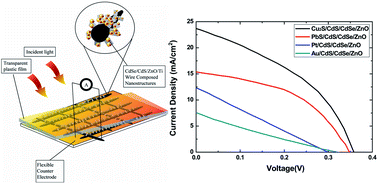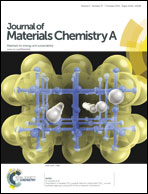Flexible quantum dot-sensitized solar cells with improved efficiencies based on woven titanium wires†
Abstract
Uniform zinc oxide (ZnO) nanosheet arrays were grown on woven titanium wires using a low temperature hydrothermal method. Photoanodes were prepared by depositing CdS and CdSe quantum dots onto the ZnO nanosheet arrays by a successive ionic layer adsorption and reaction (SILAR) method. Solar cells were assembled using these nanostructured photoanodes and their photovoltaic performance was characterized. The effect of using SILAR cycles for the deposition of quantum dots on the performance of these nanostructured solar cells was investigated systematically. The overall light-to-electricity conversion efficiency of 0.98% was achieved under 100 mW cm−2 illumination for flexible CdS/CdSe co-sensitized solar cells using conventional Pt foils as counter electrodes. To further improve the performance of the flexible solar cells, PbS and Cu2S counter electrodes based on Pb and Cu foils were fabricated. The best conversion efficiencies of flexible CdS/CdSe co-sensitized solar cells using Cu2S and PbS counter electrodes were 3.4% and 2.5%, which demonstrated a significant enhancement in values for short circuit current, open circuit voltage, and fill factor compared to those obtained with the commonly used Pt and Au electrodes.

- This article is part of the themed collection: 2014 Journal of Materials Chemistry A Hot Articles

 Please wait while we load your content...
Please wait while we load your content...